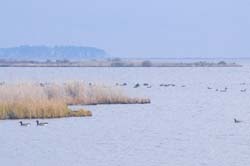Wonders of Wetlands
 Growing up, I had access to trails, open space and coastal wetlands. It helps to have grown up in California because all of this was easily available.
Growing up, I had access to trails, open space and coastal wetlands. It helps to have grown up in California because all of this was easily available.
The wetlands were the most fun because they always had something new to offer. They are crowded with life –full of marine and land elements. Painted turtles would slowly move about while newts scurried out of the way. I could see bullfrogs to diving beetles, duckweed and pondweed –all leading these secret and fascinating lives on land and in the water. Just like we have communities, I realized wetlands were communities too. Water is present at least part of the time, generally for at least a portion of the plant growing season.
Now I live in Chicago, a big metropolitan city where being out in nature may not be as easily accessible as growing up in California. However, you may still be able to find a wetland. They can be freshwater or saltwater, inland or coastal, seasonal or permanent, natural or man-made. Yes, even man-made!
For example, in Chicago I found one near a park. It didn’t exist 20 years ago but it’s there now. The area kept flooding when it rained, so the park district decided it would be easier to develop it into a small wetland because it would be easier to maintain and local schools could use it for Earth Science and Biology classes. It thrives with life now, including stocked fish, crayfish, dragonflies and other insects, turtles, tadpoles, and frogs. Kids at the local high school observe the birds near it, analyze water samples, and have used it for regional science fair projects.
Look around your town, city, or neighborhood. See if you’ve passed by a wetland all this time and didn’t even notice it was there. It may be a great jumping off point for science or environmental projects at your school.
Want to learn about wetlands, the environment and what you can do? Check out: http://water.epa.gov/type/wetlands/protection.cfm
Yvonne Gonzalez is a SCEP intern with the Air and Radiation Division in Region 5. She recently received her dual graduate degree from DePaul University.
Editor's Note: The opinions expressed in Greenversations are those of the author. They do not reflect EPA policy, endorsement, or action, and EPA does not verify the accuracy or science of the contents of the blog.

wetlands are awesome and also its very good to enjoy the nature..
i enjoyed this article..extremely useful and superb
Look around your town, city, or neighborhood. See if you’ve passed by a wetland all this time and didn’t even notice it was there. It may be a great jumping off point for science or environmental projects at your school.
California has greater prospects like this. I have not been a wetland fan, but learning about them at your blog makes me more appreciative of them.